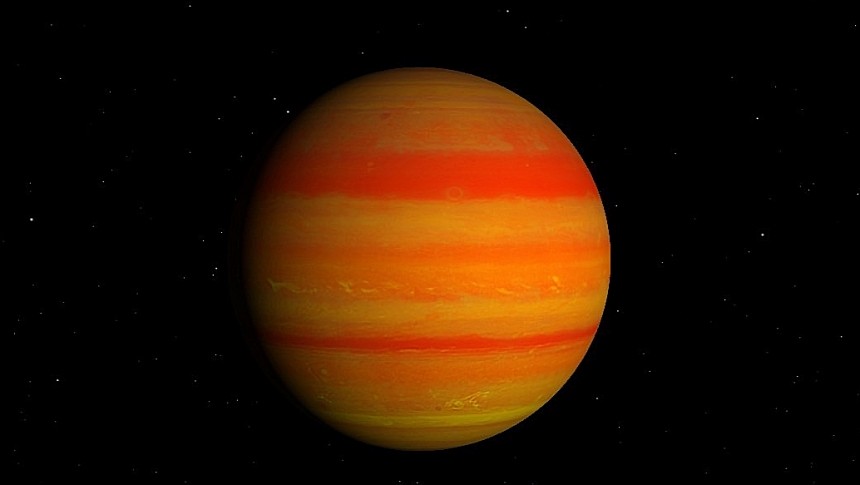NASA's exoplanet catalog has an inventory of exactly 5,338 confirmed planets. An extra 9,618 are presently in candidate status, meaning that first number is likely to rapidly go up, way up.
This weekend we've started looking through this impressive inventory, as we plan on giving you a closer look at some of the most exciting planets we know are out there. We kicked things off yesterday with a place that sparkles alluringly in the night, as if inviting visitors, only to then trap them into a hell of molten lava.
For this Sunday we have something softer in mind. A fluffy place, if you will, although it too is not very hospitable for life, at least in the form we know and understand it from here on Earth.
Enter TOI-3757 b. I know, it's not a very appealing name. Well, it's not a name per se, but a code used by astronomers to more easily identify it. Unlike yesterday's Janssen, this place does not have a name of its own yet.
That matters little in the grand scheme of things, though. The planet exists, far away in our galaxy. It spins around a K-type star 591 light years from Earth, in the constellation of Auriga, in the form of a gas giant.
The place was discovered in 2022, so it's one of the freshest entries in the NASA catalog of exoplanets. We do know some things about it, though, and some of them are quite interesting, to say the least.
First up, because this is a gas giant we're talking about, astronomers compare it to Jupiter. TOI-3757 b is just a tad larger than the planet in our own solar system, with a radius 1.071 bigger.
That makes it quite large, and this fact puts its mass quite off-balance. Despite being as large as Jupiter, it only has a fraction of its mass, 0.2. That makes it according to NASA the "lowest-density planet ever detected around a red dwarf star." It's so fluffy, as far as density is concerned, that astronomers have compared it to a marshmallow.
Another weird thing about it is that despite being a massive gas giant it's located pretty close to its star, at just 0.038 astronomical units. That allows it to complete a full orbit in just 3.4 days.
Chances of TOI-3757 b harboring carbon-based life are almost nil, first up because the place is a gas giant, and not a rocky world. Then, the star it orbits, a red dwarf, is not exactly life-friendly either: it is cooler than our own Sun, and it kind of has a habit of erupting out of the blue, with such force that even planetary atmospheres can be obliterated.
Aside for TOI-3757 b, we know of a single other planet orbiting this particular star. Details on that one are however scarce at the time of writing.
For this Sunday we have something softer in mind. A fluffy place, if you will, although it too is not very hospitable for life, at least in the form we know and understand it from here on Earth.
Enter TOI-3757 b. I know, it's not a very appealing name. Well, it's not a name per se, but a code used by astronomers to more easily identify it. Unlike yesterday's Janssen, this place does not have a name of its own yet.
That matters little in the grand scheme of things, though. The planet exists, far away in our galaxy. It spins around a K-type star 591 light years from Earth, in the constellation of Auriga, in the form of a gas giant.
The place was discovered in 2022, so it's one of the freshest entries in the NASA catalog of exoplanets. We do know some things about it, though, and some of them are quite interesting, to say the least.
First up, because this is a gas giant we're talking about, astronomers compare it to Jupiter. TOI-3757 b is just a tad larger than the planet in our own solar system, with a radius 1.071 bigger.
That makes it quite large, and this fact puts its mass quite off-balance. Despite being as large as Jupiter, it only has a fraction of its mass, 0.2. That makes it according to NASA the "lowest-density planet ever detected around a red dwarf star." It's so fluffy, as far as density is concerned, that astronomers have compared it to a marshmallow.
Another weird thing about it is that despite being a massive gas giant it's located pretty close to its star, at just 0.038 astronomical units. That allows it to complete a full orbit in just 3.4 days.
Chances of TOI-3757 b harboring carbon-based life are almost nil, first up because the place is a gas giant, and not a rocky world. Then, the star it orbits, a red dwarf, is not exactly life-friendly either: it is cooler than our own Sun, and it kind of has a habit of erupting out of the blue, with such force that even planetary atmospheres can be obliterated.
Aside for TOI-3757 b, we know of a single other planet orbiting this particular star. Details on that one are however scarce at the time of writing.






